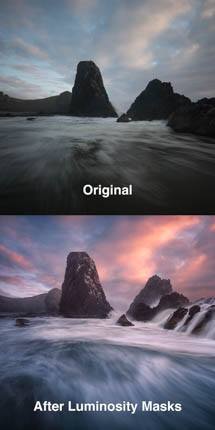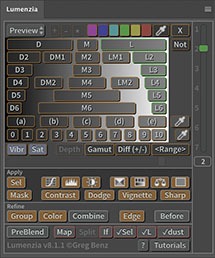Adobe just released their major annual updates at Adobe MAX, including Photoshop 2026 (PS v27), Adobe Camera RAW (ACR v18), Lightroom Classic (LrC v15). There are numerous changes and improvements, and in this post I’ll cover the ones most relevant for landscape photographers.
New in Lightroom Classic v15 / ACR v18:
The new color variance slider in point color is very interesting. You may use this to help reduce distraction from color (such as patchy grass) add color contrast (such as to make fall color pop). Expect it will take a little time to wrap your head around where and how to use it, but it’s a great tool which I believe can significantly benefit some of your images once you understand it. It does seem to shift the hue for the sampled color, which I find a bit surprising and unfortunate (especially for reference values like skin tones) – but you may offset that with a hue shift. It is available in both the global and local versions of the point color tool.
Remove dust spots has made its way over to LrC. This is a fantastic AI-based tool which does an incredibly nice job removing problems, while avoiding creating new ones. See my ACR dust removal tutorial for a deeper look at how to get the most out of this great tool.
The new HDR limit slider replaces what was previously a dropdown. This is significant for those of you editing HDR as it will now cause clipping of highlights in your images at a much lower level than before (2.3 vs 4.0 stops) under default settings. The old limit was safe for nearly all use and this is a control most users probably ignored. The new limit will force you to edit some images either more modestly (which is probably a good thing for beginners prone to “turning it up to 11”) or start changing a control you previously ignored. It allows more granular control (can set it to the nearest tenth of a stop, rather than only 1, 2, 3, 4 or 8). The slider also shows a red marking indicating the current headroom limit of your display.
Overall, I am not a fan of this lower HDR limit. 4 stops is often useful for subjects light sunsets and city lights, and you will be forced to adjust this slider frequently if you edit that kind of work. If you fail to set it correctly, you may easily create a slight degree of clipping (especially in small color details). Setting the old limit higher than what your edit uses or your monitor supports has absolutely no downside if you are editing properly (the exported image specify the headroom based on either the brightest pixel or this limit, whichever is lower). To some degree, this may help novices avoid the worst abuses of HDR editing – but overall it creates more work for skilled creatives as well as a risk of minor clipping which could be avoided. You cannot fix this with an import setting (you cannot manage across SDR + HDR edits, and marking every image as containing an edit impacts performance). I would like to see an option added in LrC preferences to set 4.0 as the default limit to help support HDR work for skilled users.
However, it’s the new reality and I recommend managing it as follows:
- Try to keep your edit within the default 2.3 stops. Many users overdo it and this is a good practice. Use tools like negative highlights or whites to constrain the highlights.
- If the image truly merits using a larger range, increase up to 4.0 stops. I would generally avoid going above 4 as very little content would benefit artistically, almost no consumer displays will show any benefit, and this is stretching the bounds of JPG gain maps (AVIF gain maps would be ok). Under no circumstance would I go above 5.6 stops (you’re starting to hit some hard technical limits there).
Preferences / External Editing now lets you set different export settings for SDR vs HDR editing, including color space, bit depth, resolution, and compression. The key here is the ability to select a different color space for SDR vs HDR. I recommend using Rec.2020 for both (as these are working edits not export), but this will be of interest to those who prefer Adobe RGB or ProPhoto RGB for SDR work (theoretically, ProPhoto includes some printable green/cyan values outside of Rec2020). Your SDR layered files should alway be 16-bit, resolution has no meaningful use for HDR, and you’re likely going to select the same compression type for all your images.
Other notable updates for landscape work:
- Dust Removal is now a mainstream feature (moves out of early access)
- AI Landscape masking can now target snow
- 8 new adaptive landscape presets
As is typical, this update includes support for many new cameras and lenses, performance updates, and bug fixes.
The biggest update is for AI culling. I believe that will be tremendously useful for many photographers photographing weddings, families, or other group events. Landscape photographers who shoot events or lots of family photos are likely to appreciate this feature, even if this release does not contain many controls specific to landscape images.
New in Photoshop 2026:
The Remove Tool is now available with upgraded quality when you set it to to the new “remove tool 3” (via dropdown in the tool bar just left of “sample all layers”). It offers options for generative remove (auto seems to work well), and they do NOT use generative credits. This seems like a very nice improvement and is one of the most exciting updates in PS 2026.
The color and vibrance adjustment layer (previously just called “vibrance”) offers temp and tint controls. This looks exactly like using the Camera RAW Filter for white balance adjustments on your rasterized data, but is faster and simpler for many workflows. This is a great addition. (Note that you should continue to use ACR to adjust temp/tint on the RAW data where possible for best results).
Select Subject and Remove background offer much better results for complex edges. The results here are quite impressive.
Harmonize.
Other notable updates (less applicable for most landscape photographers):
- File / Place Free Adobe Stock Images is a nice way to get some generic content.
- Image / Generative Upscale now offer models from Topaz, including Gigapixel and Bloom. The results here are quite impressive. However, it is a premium features which costs more (you’ll need something like a FireFly subscription and sufficient credits). For landscape photographers making prints, the standalone Topaz Gigapixel tool offers more capability / flexibility than the integrated version of Topaz without a new Adobe subscription, while being nearly as easy to use (as it also integrated with PS).
- Edit / Generative Fill now integrates Nano Banana / Flux. The results are interesting, and I think bode very well for the future. However, the current implementation is low resolution only suitable for small replacements or exporting social images. More significantly, I found that the results do not integrate well into the surroundings well in many cases even when I explicitly request no changes to specific elements in the target area. I would happily pay if the results were full resolution and well matched to the image, but my experience thus far falls short of what I would consider to be useful results on a reasonably consistent basis. For those of you subscribed to the Photography plan (for LR + PS), you will be prompted to add a “FireFly” plan and can select 2000 credits per month for $10 per month (or $99 per year when you select annual billing).

